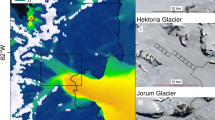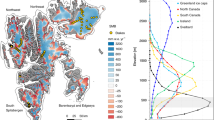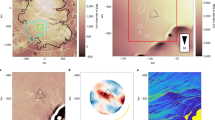Abstract
Meltwater beneath the large ice sheets can influence ice flow by lubrication at the base or by softening when meltwater refreezes to form relatively warm ice1,2,3. Refreezing has produced large basal ice units in East Antarctica4. Bubble-free basal ice units also outcrop at the edge of the Greenland ice sheet5, but the extent of refreezing and its influence on Greenland’s ice flow dynamics are unknown. Here we demonstrate that refreezing of meltwater produces distinct basal ice units throughout northern Greenland with thicknesses of up to 1,100 m. We compare airborne gravity data with modelled gravity anomalies to show that these basal units are ice. Using radar data we determine the extent of the units, which significantly disrupt the overlying ice sheet stratigraphy. The units consist of refrozen basal water commonly surrounded by heavily deformed meteoric ice derived from snowfall. We map these units along the ice sheet margins where surface melt is the largest source of water, as well as in the interior where basal melting is the only source of water. Beneath Petermann Glacier, basal units coincide with the onset of fast flow and channels in the floating ice tongue. We suggest that refreezing of meltwater and the resulting deformation of the surrounding basal ice warms the Greenland ice sheet, modifying the temperature structure of the ice column and influencing ice flow and grounding line melting.
This is a preview of subscription content, access via your institution
Access options
Subscribe to this journal
Receive 12 print issues and online access
$259.00 per year
only $21.58 per issue
Buy this article
- Purchase on Springer Link
- Instant access to full article PDF
Prices may be subject to local taxes which are calculated during checkout




Similar content being viewed by others
References
Stearns, L. A., Smith, B. E. & Hamilton, G. S. Increased flow speed on a large East Antarctic outlet glacier caused by subglacial floods. Nature Geosci. 1, 827–831 (2008).
Lliboutry, L. Local friction laws for glaciers: A critical review and new openings. J. Glaciol. 23, 67–95 (1979).
Cuffey, K. M. & Paterson, W. S. B. The Physics of Glaciers (Academic, 2010).
Bell, R. E. et al. Widespread persistent thickening of the East Antarctic ice sheet by freezing from the base. Science 331, 1592–1595 (2011).
Reeh, N., Oerter, H. & Thomsen, H. H. Comparison between Greenland ice-margin and ice-core oxygen-18 records. Ann. Glaciol. 35, 136–144 (2002).
Bell, R. E. et al. Origin and fate of Lake Vostok water frozen to the base of the East Antarctic ice sheet. Nature 416, 307–310 (2002).
Wolovick, M. J., Bell, R. E., Creyts, T. T. & Frearson, N. Identification and control of subglacial water networks under Dome A, Antarctica. J. Geophys. Res. 118, 140–154 (2013).
Gudmandsen, P. Layer echoes in polar ice sheets. J. Glaciol. 15, 96–101 (1975).
Legarsky, J., Wong, A., Akin, T. & Gogenini, S. P. Detection of hills from radar data in central-northern Greenland. J. Glaciol. 44, 182–184 (1998).
Gogineni, P. in CReSIS Radar Depth Sounder Data (2012); http://data.cresis.ku.edu/
Cochran, J. R. & Bell, R. E. IceBridge Sander AIRGrav L1B Geolocated Free Air Gravity Anomalies (NASA DAAC at the National Snow and Ice Data Center, 2012).
Karlsson, N. B., Dahl-Jensen, D., Gogineni, S. P. & Paden, J. D. Tracing the depth of the Holocene ice in North Greenland from radio-echo sounding data. Ann. Glaciol. 54, 44–50 (2013).
Van Angelen, J. H. et al. Sensitivity of Greenland ice sheet surface mass balance to surface albedo parameterization: a study with a regional climate model. The Cryosphere 6, 1175–1186 (2012).
Wolovick, M., Bell, R. E., Roger Buck, W. & Creyts, T. T. Controls on the Geometry of Accretion Reflectors abstr. C33E-03 (AGU Fall meeting, 2012).
Catania, G. A., Neumann, T. A. & Price, S. F. Characterizing englacial drainage in the ablation zone of the Greenland ice sheet. J. Glaciol. 54, 567–578 (2008).
Flowers, G. E. & Clarke, G. K. C. Surface and bed topography of Trapridge Glacier, Yukon Territory, Canada: digital elevation models and derived hydraulic geometry. J. Glaciol. 45, 165–174 (1999).
Shreve, R. L. Movement of water in glaciers. J. Glaciol. 11, 205–214 (1972).
Creyts, T. T. & Clarke, G. K. Hydraulics of subglacial supercooling: Theory and simulations for clear water flows. J. Geophys. Res. 115, F03021 (2010).
Andersen, K. K. et al. High-resolution record of Northern Hemisphere climate extending into the last interglacial period. Nature 431, 147–151 (2004).
Oswald, G. & Gogineni, S. Recovery of subglacial water extent from Greenland radar survey data. J. Glaciol. 54, 94–106 (2008).
Hindmarsh, R. C., Leysinger Vieli, G. J., Raymond, C. & Gudmundsson, G. H. Draping or overriding: The effect of horizontal stress gradients on internal layer architecture in ice sheets. J. Geophys. Res. 111, F02018 (2006).
Dahl-Jensen, D. et al. Eemian interglacial reconstructed from a Greenland folded ice core. Nature 493, 489–494 (2013).
Dahl-Jensen, D., Niels, G., Prasad Gogineni, S. & Miller, H. Basal melt at NorthGRIP modeled from borehole, ice-core and radio-echo sounder observations. Ann. Glaciol. 37, 207–212 (2003).
Bamber, J. L., Siegert, M. J., Griggs, J. A., Marshall, S. J. & Spada, G. Paleofluvial mega-canyon beneath the Central Greenland ice sheet. Science 341, 997–999 (2013).
Joughin, I., Smith, B., Howat, I. & Scambos, T. MEaSUREs Greenland Ice Velocity Map from InSAR Data (National Snow and Ice Data Center, 2010).
Rignot, E. & Steffen, K. Channelized bottom melting and stability of floating ice shelves. Geophys. Res. Lett. 35, L02503 (2008).
Le Brocq, A. M. et al. Evidence from ice shelves for channelized meltwater flow beneath the Antarctic ice sheet. Nature Geosci. 6, 945–948 (2013).
Joughin, I., Fahnestock, M., MacAyeal, D., Bamber, J. L. & Gogineni, P. Observation and analysis of ice flow in the largest Greenland ice stream. J. Geophys. Res. 106, 34021–34034 (2001).
Horgan, H. J. et al. Complex fabric development revealed by englacial seismic reflectivity: Jakobshavn Isbræ, Greenland. Geophys. Res. Lett. 35, L10501 (2008).
Bamber, J. L. et al. A new bed elevation dataset for Greenland. The Cryosphere 7, 499–510 (2013).
Acknowledgements
The authors acknowledge support from NASA and NSF for this manuscript. The Operation IceBridge mission provided critical data for this analysis. The radar data from the CReSIS radar systems and the Sander Geophysics Ltd. AirGrav gravity data were central to this work. L. Altman, B. Bell and S. Starke provided support in analysis of the data and production of the figures. R. Buck provided feedback that improved the paper substantially. LDEO contribution number 7800.
Author information
Authors and Affiliations
Contributions
R.E.B. designed the experiment as part of the NASA Icebridge Science Team. K.T. collected and analysed gravity data. I.D. conducted analysis of shallow and deep ice radar. M.W. conducted analysis of deep ice radar. W.C. conducted analysis of deep ice radar and the water routing calculation. T.T.C. contributed to the water routing calculation. N.F. conducted analysis of deep ice radar. A.A. conducted analysis of deep ice radar. J.D.P. collected and reduced radar data. All authors participated in the interpretation and writing of the paper.
Corresponding authors
Ethics declarations
Competing interests
The authors declare no competing financial interests.
Supplementary information
Rights and permissions
About this article
Cite this article
Bell, R., Tinto, K., Das, I. et al. Deformation, warming and softening of Greenland’s ice by refreezing meltwater. Nature Geosci 7, 497–502 (2014). https://doi.org/10.1038/ngeo2179
Received:
Accepted:
Published:
Issue Date:
DOI: https://doi.org/10.1038/ngeo2179
This article is cited by
-
Shear margins in upper half of Northeast Greenland Ice Stream were established two millennia ago
Nature Communications (2024)
-
Three-dimensional topology dataset of folded radar stratigraphy in northern Greenland
Scientific Data (2023)
-
Holocene ice-stream shutdown and drainage basin reconfiguration in northeast Greenland
Nature Geoscience (2022)
-
Uppermost crustal structure regulates the flow of the Greenland Ice Sheet
Nature Communications (2021)
-
A first constraint on basal melt-water production of the Greenland ice sheet
Nature Communications (2021)



